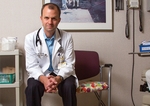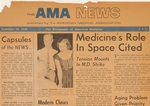Business
Automation seen to aid informed consent
■ A practical look at information technology issues and usage
By Pamela Lewis Dolan — covered health information technology issues and social media topics affecting physicians. Connect with the columnist: @Plewisdolan — Posted Aug. 11, 2008.
- WITH THIS STORY:
- » Correction
- » Related content
To improve the informed consent process in a way that leads to patients who are, in fact, more informed, some physicians are turning to technology.
These doctors are finding that using more interactive, automated processes helps patients retain more information. They also allow patients to ask questions as they come up, rather then trying to think of them during the comparatively pressurized situation of an office visit. And a few doctors also have found that an automated informed consent process can help provide a defense against liability.
An automated informed consent process "significantly improves the efficiency and certainly the quality of the consent process which is so vital to the practice of medicine," said Neil Baum, MD, a New Orleans urologist who helped create an automated system called iMed, which is offered by Atlanta-based Dialog Medical.
Some automated systems can create a tailor-made consent form that is specific to the patient and procedure as well as including state-specific or even hospital-specific requirements.
Other systems, used in conjunction with the traditional forms, utilize tools such as video and automatically generated educational materials. A patient can watch and review those materials outside of the office.
On average, automated systems cost a few hundred dollars per year, per physician. But advocates say the systems can not only eliminate the need for staff members to maintain stacks of paper forms, but they can also save physician time by making the patient education process more efficient and, in some cases, moving it outside the office.
Since the Joint Commission added to its 2007 National Patient Safety Goals that hospitals and clinics encourage more participation from patients in their own care, there has been much talk about the "patients as partners" concept of care. The more patients know about their options, the better suited they are to make informed decisions.
The American College of Surgeons conducted a survey in 2006 that found 80% of its members were using only verbal consent and only 15% had an informed consent process that met ACS and American Medical Association guidelines. Ninety percent said they wanted the ACS to develop materials that met ACS/AMA guidelines. ACS and AMA guidelines state informed consent should contain four basic elements: nature of the procedure, risks, benefits and alternative treatments. (See correction)
David Song, MD, associate professor of surgery and chief of plastic and reconstructive surgery at the University of Chicago Medical Center, said when he realized it sometimes took more than an hour to do in-office consultations with patients who retained only about 20% of what was discussed, he knew he needed a better solution.
Dr. Song partnered with Emmi Solutions, a Chicago-based technology company that develops interactive online programs. The system walks patients through procedures and explains the benefits and risks at a pace the patient can control. The Emmi system is used as an adjunct to the traditional consent forms.
Woody Denham, MD, director of minimally invasive surgery at Evanston Northwestern Healthcare and chief of surgery at Highland Park Hospital in the Chicago suburbs, has used Emmi since 2004 and said the conversations with his patients have changed as a result.
While he doesn't require his patients to watch the program, Dr. Denham said he can always tell the ones who have. "They have a much better understanding of the procedure," he said. "They get what's going on."
He said even though no doctor would tell a patient he doesn't have time to answer his or her questions, patients understand the time constraints doctors are under. "Patients aren't comfortable asking questions over and over," he said.
"You would ask a car dealer many more questions about your new car than you would about a procedure you want to have done to yourself. It makes no darn sense," Dr. Denham said.
For David Arnold, MD, associate professor of head and neck surgery at the University of Miami Miller School of Medicine, it wasn't explaining procedures to patients that was causing problems. It was the actual documentation of the consent that needed improving.
He said a lack of consistency between departments at a health system with 3,000 beds stretched across 60 acres was problematic. Use of iMed at his hospital was driven by the facility's risk management department but has made his own practice much more efficient and protected by having some standardization.
For James E. Gottesman, MD, a urologic oncologist from Seattle, a liability case confirmed his decision to become an early adopter of automated informed consent.
A patient who had been diagnosed with cancer after a third biopsy that followed two negative ones sued Dr. Gottesman in the mid-1990s, claiming the cancer should have been caught sooner. Dr. Gottesman won the legal battle and was told afterwards by the jury that it was the informed consent process that helped clear him. The documents, which the patient signed off on as understanding, stated that additional biopsies could be necessary to detect cancer in the future.
"From that point on I became a zealot," said Dr. Gottesman.
Pamela Lewis Dolan covered health information technology issues and social media topics affecting physicians. Connect with the columnist: @Plewisdolan —












